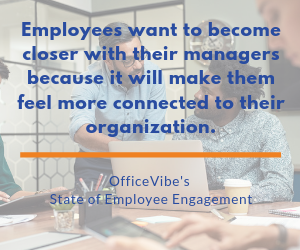When taking a leadership role at any organization, implementing a culture of employee engagement should be your initial focus. This is especially important when you consider that only 33 percent of the American workforce is engaged with their work, according to Gallup’s State of the American Workplace report—and your organization is likely no exception.
Luckily, in your position, you’re poised to make the changes needed to get employees engaged, promoting a sense of commitment and excitement about being a part of the company. With a commitment to education, purpose, and better hiring, you can champion effective employee engagement strategies in your new leadership role.
Promote a Blended Learning Strategy for In-House Training
According to Udemy’s 2018 Millennials at Work study, 42 percent of employees said learning and development was the most important benefit when deciding where to work. Training and educating employees is the best way to increase retention and make you look good as a new leader.
The key is getting it right. The same old boring learning program will do anything but engage employees. Avoid this potential setback by implementing a blended learning strategy, which incorporates both online and in-person learning. Lisa Burke, a talent pool development expert, explains in Blended Learning: A Training Strategy That Fosters ROI, why this is so effective:
“Blending online instruction with in-person interaction results in a more dynamic learning experience and helps employees retain the information much faster than if they were presented with solely a two-hour lecture or two-hour WebEx video. The classroom session with in-person discussion and activities serves to solidify information in the learner’s mind since employees will be taking an active and interactive role in the instructional process.”
Blended learning is also easy to implement with any size company. With many online learning options available to businesses, find the best one for your budget, and use in-house experts, like senior employees, to solidify the learning with in-person sessions.
Create a Sense of Purpose for All Employees
Employees want to feel they have a purpose within the company. So much so, that engagement soars when they feel their work is meaningful and matters, according to the same Gallup workplace report. The report also found that employees who strongly believe that they’re able to link their goals to the organization’s goals are 3.5 times more likely to be engaged, yet only 4 percent of employees feel that connection.
To drive engagement, make this connection clear for every employee by providing regular feedback. Knowing how their work and skills contribute to the overall company success allows employees to see that connection between them and the company. Further, these contributions can be elevated by featuring employee efforts and know-how on social media via the company employee advocacy program.
What’s more, 70 percent of employees want to spend more time with their manager, according to OfficeVibe’s State of Employee Engagement. This relationship can continue to build the connection to purpose and value within the company. As OfficeVibe explains, “Employees want to become closer with their managers because it will make them feel more connected to their organization.”

Making time for feedback allows you to connect face-to-face and make more of that one-on-one time, ensuring your employees feel both engaged and connected to a purpose. This extra time together allows you to continually assess employee goals, keeping them focused on how they’re growing in their career and their company.
Improve Your Hiring
One overlooked element of employee engagement is making the right hire. The State of the American Workplace explains, “When employees are a mismatch for their role and organization, they often struggle to succeed or become bored and restless. Their days—even their careers —can feel wasted, along with their sense of purpose. Workers want roles and employers that allow them to make the most of their strengths.”
To avoid a lack of employee engagement in the first place, you must start by hiring the right people for the company and the role. RecruitBox shares five important tips for finding the best candidate, not just the best interviewer—an easy mistake to make:
- Give them a problem to solve: Pose the problem in the application process and then ask your short list of candidates to explain their reasoning. “By discussing their thinking behind their solution, you’ll verify both their skills (the steps they would take to fix the problem) as well as their behaviors (how they would approach each step),” says RecruitBox.
- Give them a project to complete: Give them a project similar to one they’d need to complete if they were hired for the job. This allows you to avoid the issue of choosing someone who isn’t yet ready, skill-wise, for the role.
- Take the candidate out of the “interview zone:” Take the candidate out to lunch or to meet some employees. Before you do, however, know what you’ll be looking for: how do they respond to employees? How do they interact? Are they interested in the people they meet?
- Listen to the candidate to share about their passion: This gives you insight into who the employee is outside of work, which inevitably is a part of who they are as an employee in the workplace.
- Get feedback from people they meet: If they interact with employees, get everyone’s opinion to paint a clear picture of who this person is and how they fit in the role and the company.
Champion Engagement as a a New Leader
Make a great first impression as you step into your new role by focusing on engagement and cultivating a team of employees who care about the organization and their jobs. Use these ideas to make that a reality, putting education, purpose, and hiring at the forefront of your goals for the first few months as a leader.


